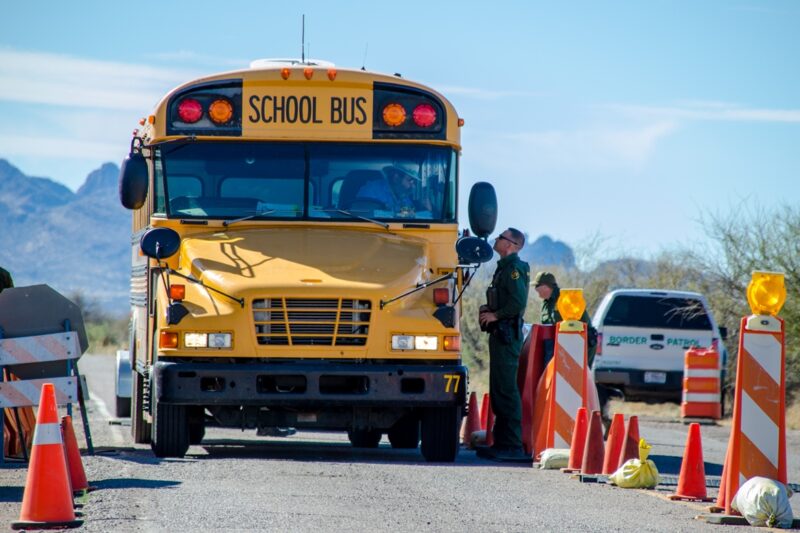Welcome to the Border Region Where the Border Patrol Has Implemented Its Own Southwest ‘Stop and Frisk’ Policy


A woman is driving home at 9:30 p.m. with her four-year-old daughter. She pulls into a rest stop. A vehicle appears behind her, with headlights so bright she can’t see. Nervous, she drives away. The other vehicle follows, tailgating her at 60 mph. She switches lanes. The vehicle does too. After several miles, emergency lights come on.
At the roadside, a Border Patrol agent with a hand on his gun approaches. Another agent scans the woman’s car with a flashlight, illuminating her daughter’s face. They’re about 75 miles away from the border in Arizona. “You seem nervous,” one agent says. “Only criminals and people trying to hide things get nervous.” The agent interrogates her, searches personal belongings, and finally releases the car without explanation. Out of fear, the woman resolves to avoid driving at night. Her daughter has recurring nightmares.
Welcome to life in the border region, where Border Patrol’s de facto policy of “stop and frisk” is familiar to local residents and yet concealed from public view. A new ACLU of Arizona report — based on government records obtained through Freedom of Information Act litigation — sheds light on Border Patrol’s vast “interior enforcement” operations, which take place, without meaningful oversight, far from any border.
Border Patrol’s own records undermine the agency’s claims that these operations are “safe, efficient, and cost-effective.” Documents contain multiple accounts of Border Patrol agents stopping and searching motorists without justification; threatening residents with assault rifles, Tasers, and knives; destroying and confiscating personal property; interfering with efforts to video-record agents; and using dozens of false alerts by CBP dogs to search and detain innocent people.
These are not just a few “bad apples.” The records show Border Patrol systematically disregarding the law with impunity. One supervisor instructed agents to “stop any vehicle on the US/Mexico border road” based on the “mere presence of the vehicle.” The supervisor allegedly “didn’t care if it was the Chief of the Border Patrol and the agent conducted a high risk traffic stop removing the Chief . . . at gun point.”
There is no indication that the supervisor was reprimanded.
“You seem nervous,” one agent says. “Only criminals and people trying to hide things get nervous.”
None of these incidents resulted in any significant discipline. This is consistent with past reports on CBP’s failure to investigate, much less punish, agents who violate border residents’ rights. The ACLU has documented many similar complaints about Border Patrol’s interior checkpoints and roving patrols in recent years, and those complaints were not properly investigated either. Oversight is so lax that Border Patrol doesn’t even document any stops that don’t result in an arrest, even if the stop leads to lengthy detention or property damage — a practice clearly out of line with accepted standards.
Yet for all of the harms caused by Border Patrol’s interior operations, they result in relatively few apprehensions of unauthorized border-crossers. For example, Tucson Sector interior-checkpoint apprehensions in 2013 accounted for only 0.67 percent of the sector’s total apprehensions. Yuma Sector checkpoint arrests of U.S. citizens exceeded those of non-citizens by a factor of nearly eight. |
Despite the Supreme Court’s prohibition on general “crime control” checkpoints, the agency’s records bear out that Border Patrol checkpoints are more directed at drug busts than immigration enforcement. Indeed, it was previously revealed that roughly 80 percent of recorded Border Patrol drug arrests were of U.S. citizens. Despite CBP Commissioner Kerlikowske’s promise a year ago to review all checkpoints by expanding data analysis of their efficacy, no statistics have been released or changes announced.
In that same interview, the commissioner said: “You can’t separate transparency from accountability.” Yet the fact that the ACLU had to file a lawsuit in order to obtain these public records is telling. CBP’s own records show that at a time of growing national attention to police accountability, the nation’s largest law enforcement agency has yet to reform its culture based on best practices like transparent data collection, a ban on racial profiling, or discipline for agents who violate civil rights.
Border residents are rightly impatient for change at CBP: Whether CBP takes this report seriously will be a good gauge of the agency’s true intentions.

